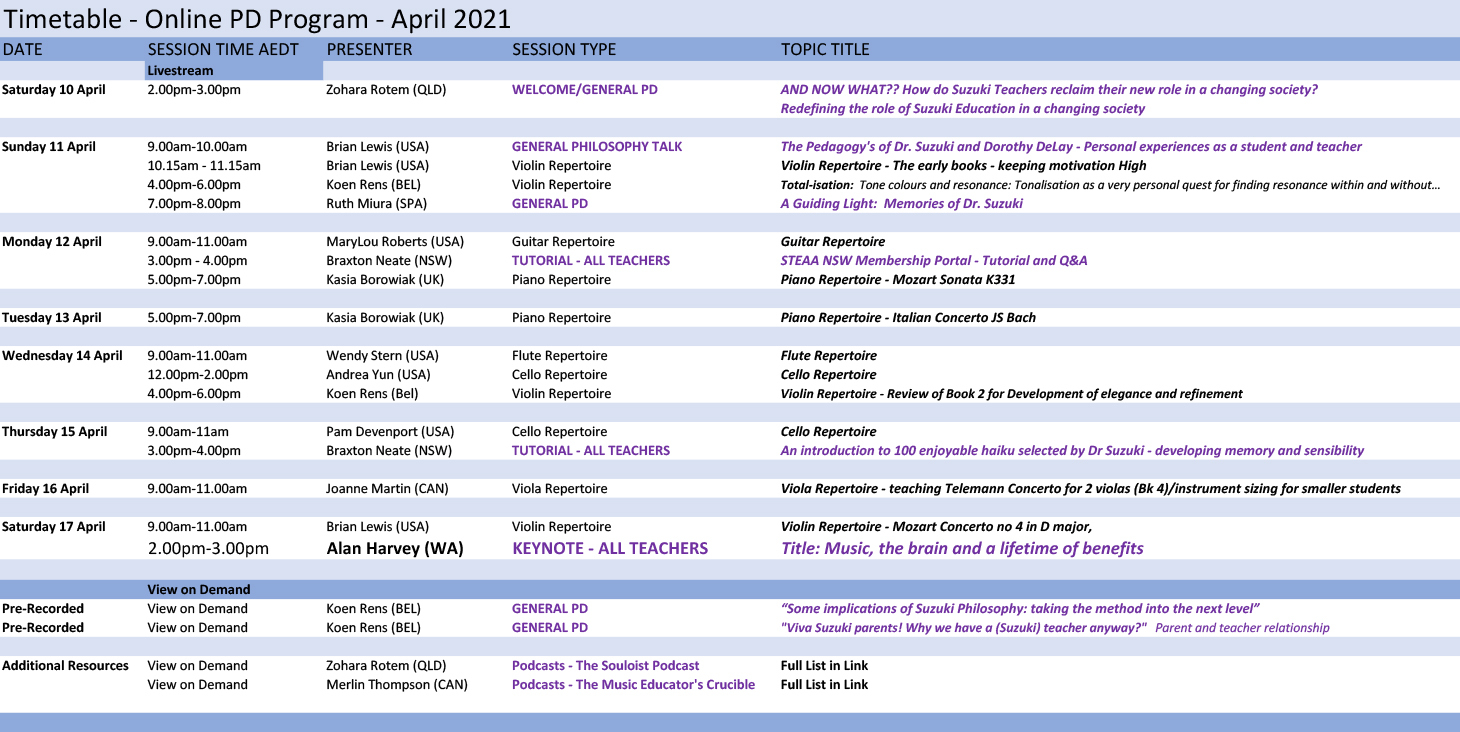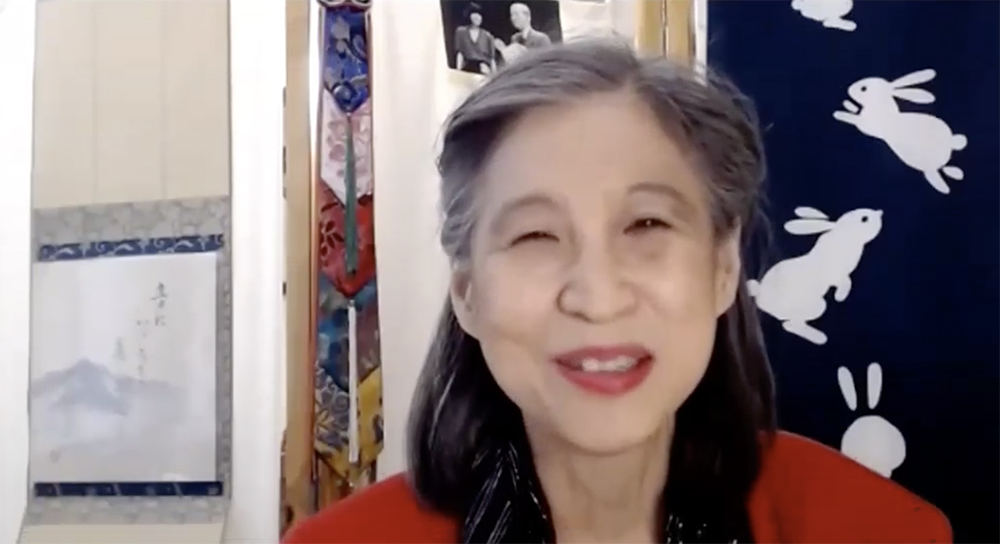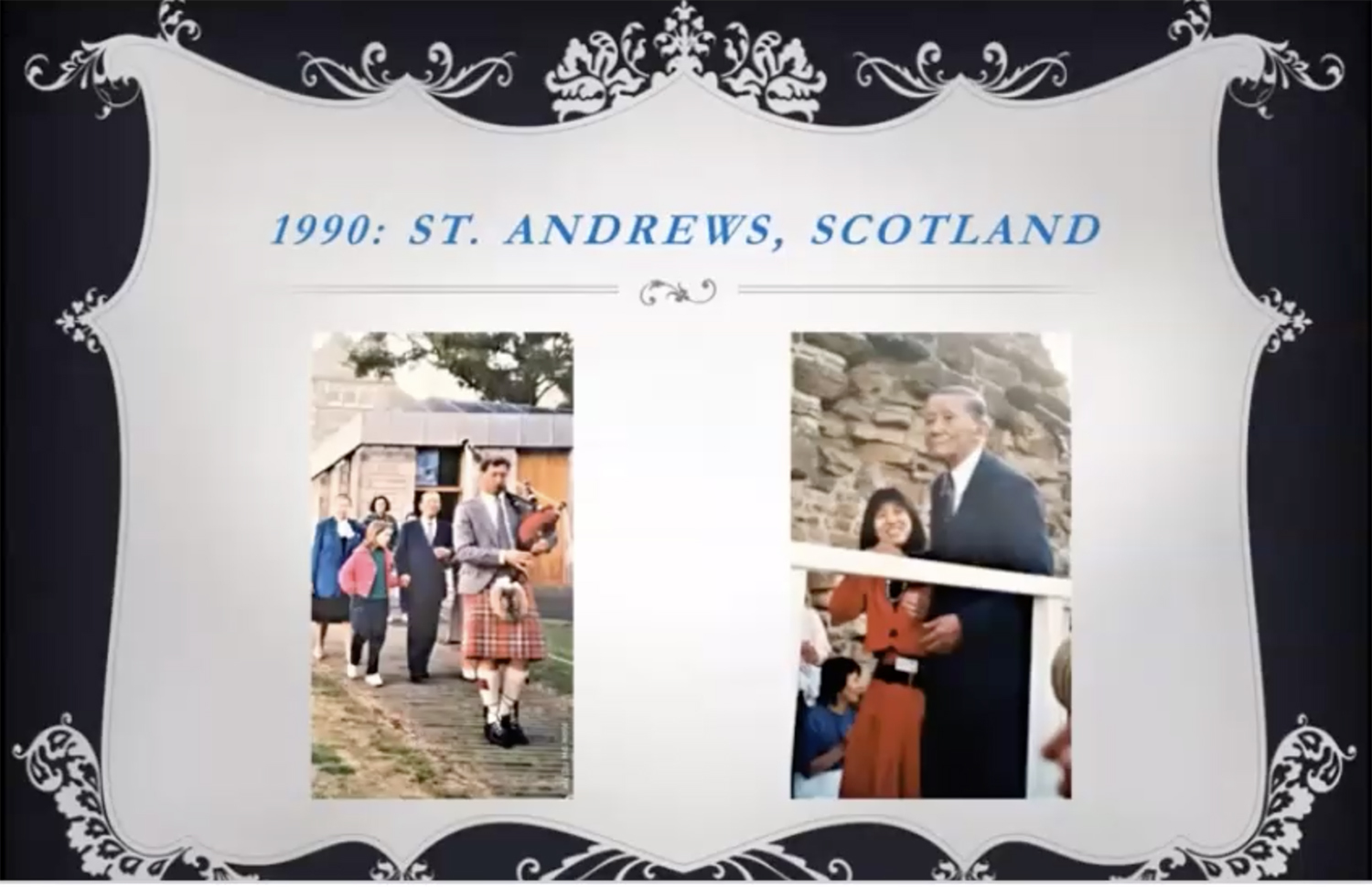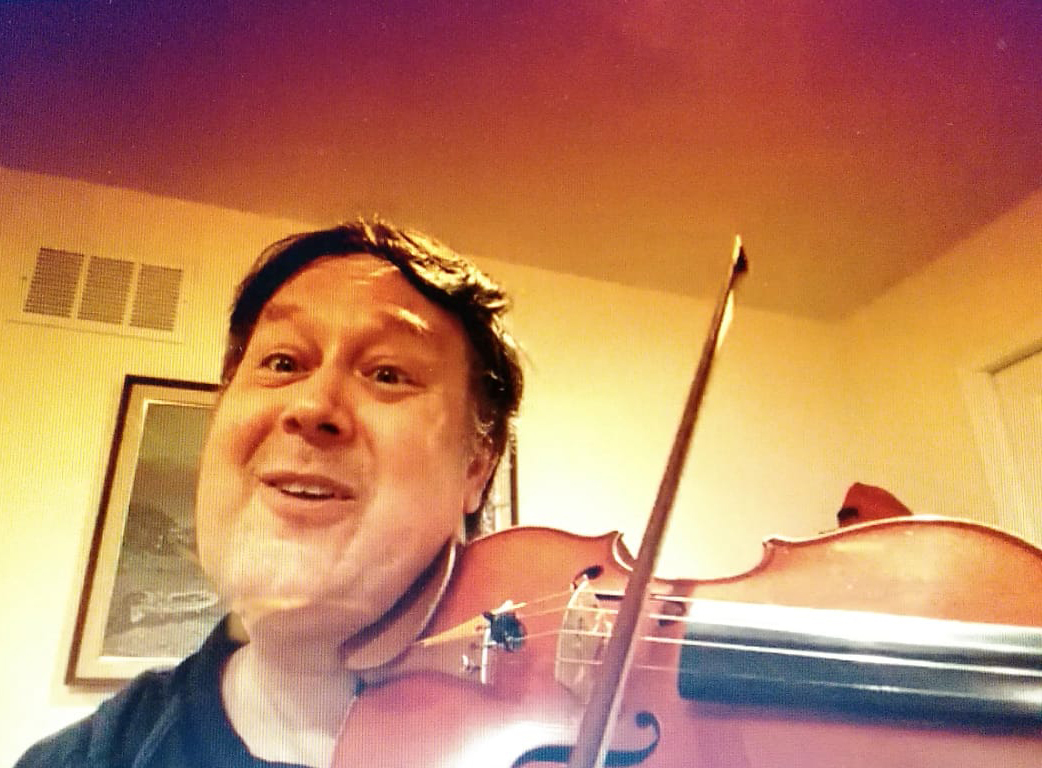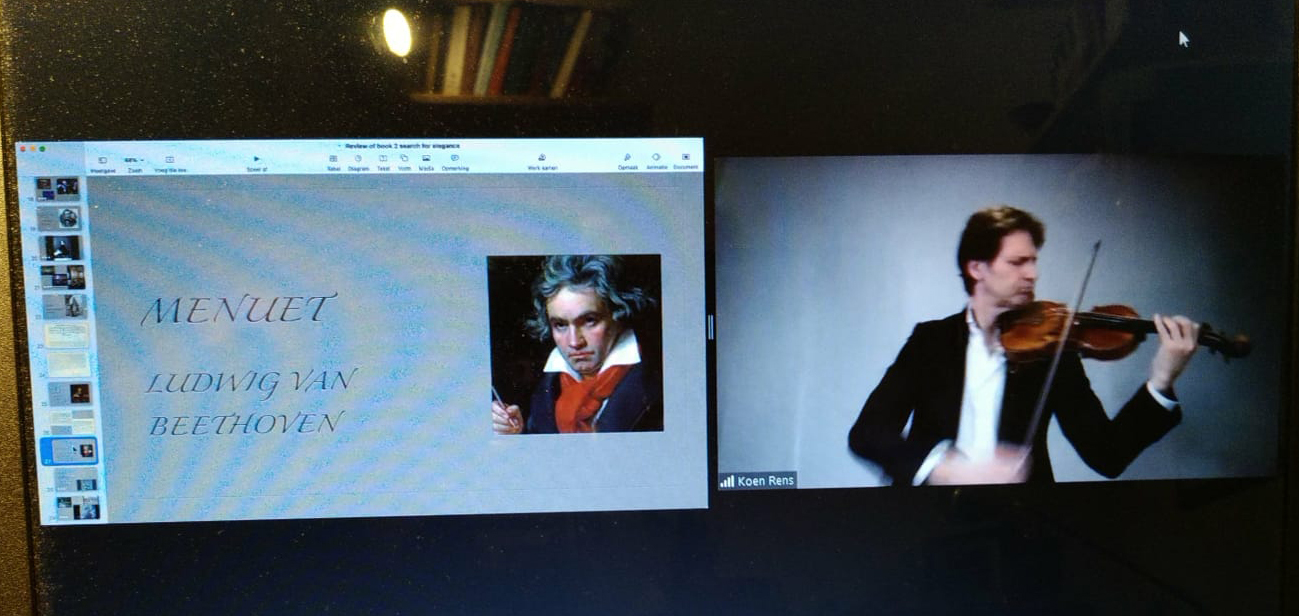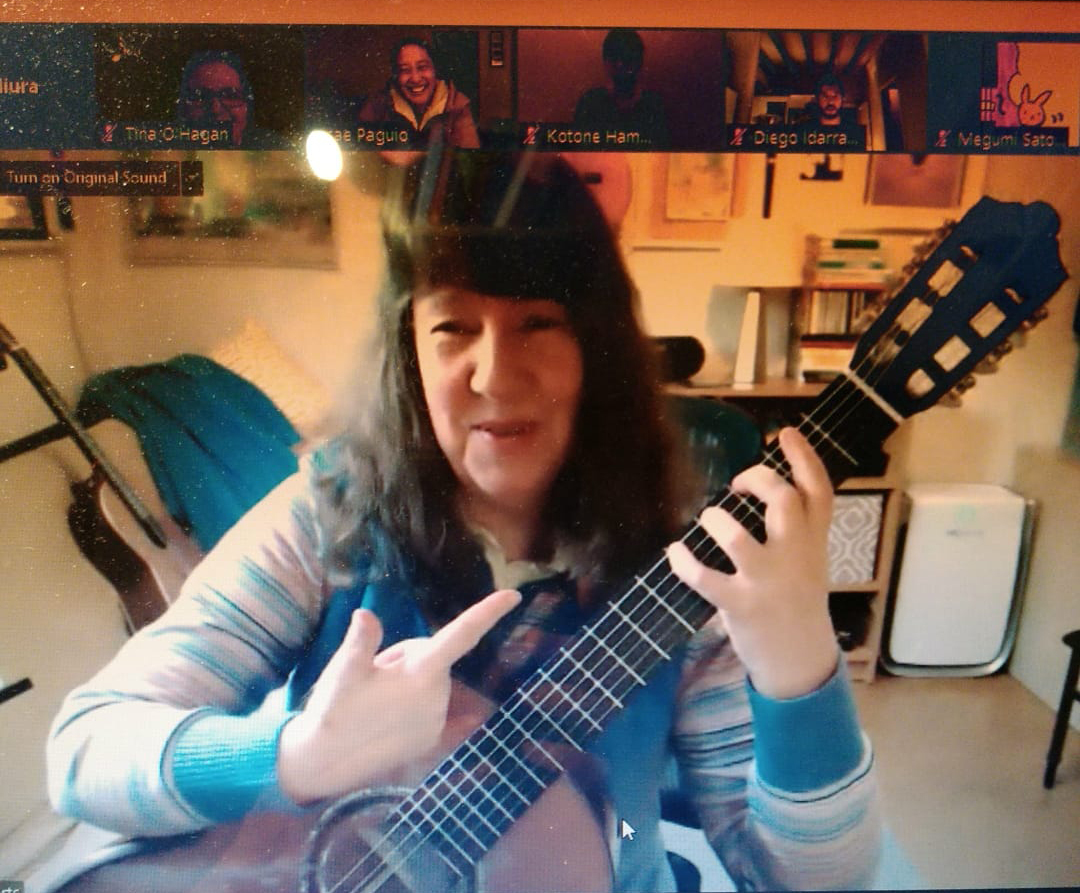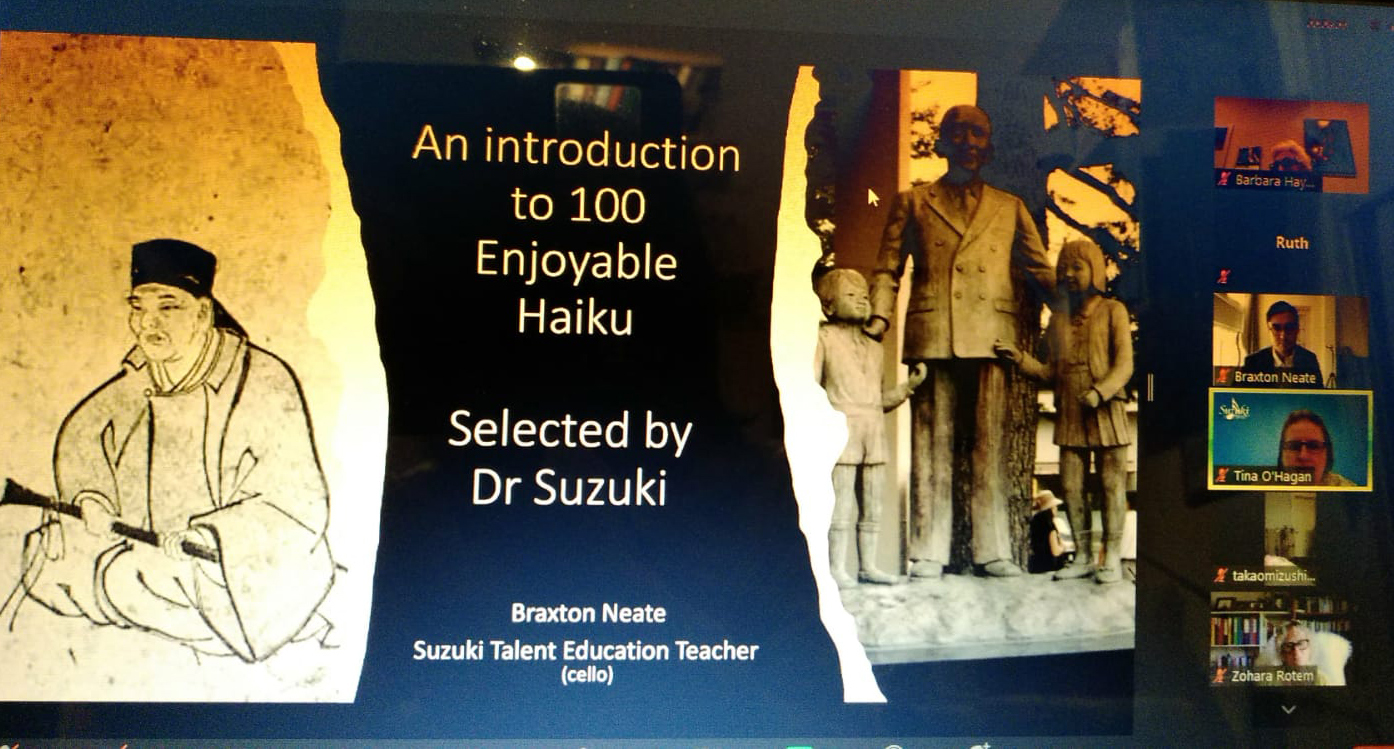4月10日〜18日にシドニーで開催された指導者向けのオンライン研究会
「Professional Development」を ルース三浦先生が報告
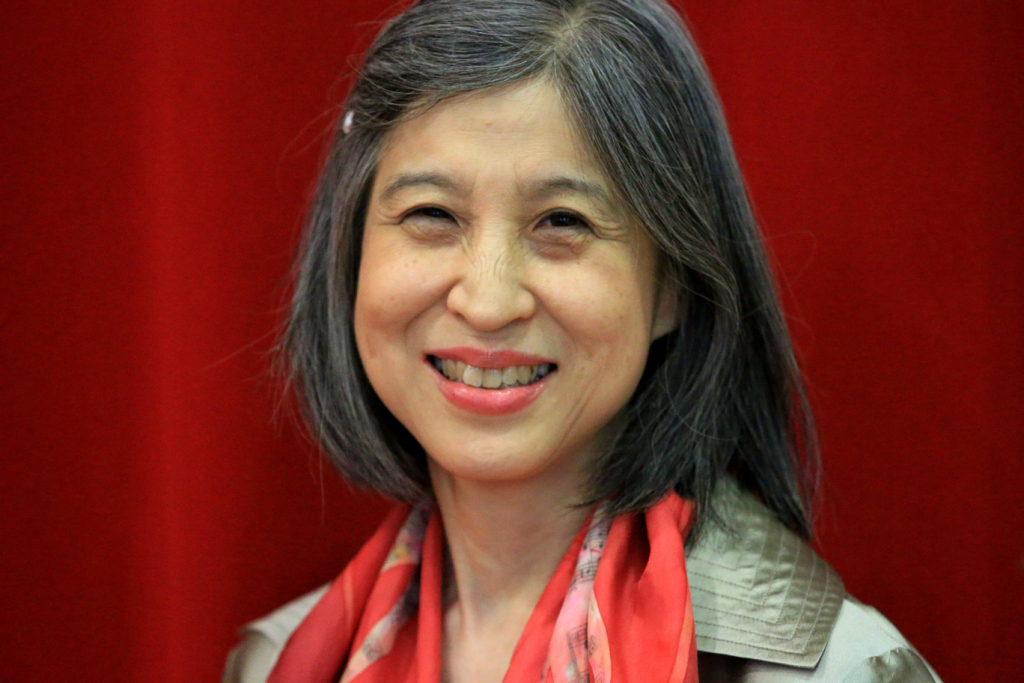
ルース三浦先生
マンスリースズキ編集部から、オーストラリアのニュー・サウス・ウェールズ(NSW)州でスズキ・ミュージックが開催した、スズキ・メソードの指導者向けProfessional Developmentに、バルセロナから参加することを話していたので、その概要を書いてほしいと依頼されました。そこで、シドニーオフィスのスズキ・アドミニストレーター、ティナ・オヘーガンにお願いしたところ、このオンライン・コースのほぼすべてのプレゼンテーションにログインすることができました。彼女はこのプログラムを見事にオーガナイズされていて、協会の著名なスズキの先生方数名が各セッションの前に歓迎の気持ちを込めて紹介してくださいました。こうした機会を作ってくれたマンスリースズキ編集部とオーストラリアの皆様に感謝します。
この1年間、スズキの年間行事の多くは、その活動を継続するためにオンライン化せざるを得ませんでした。しかし、かえってそれが利点となったことの一つは、スズキの国際的なコミュニティがさらに緊密になり、Zoomセッションで豊富な国際的チューターや講師を提供することで、お互いに学び合うことができるようになったことです。
オーストラリアのスズキの指導者は、会員資格を維持し、生徒を卒業させるために、年に最低10時間の専門的な指導者研究会に参加することが義務付けられています。 今回のような催しは、シドニーだけでなく、メルボルンでも同様で、オーストラリアの真冬にあたる7月開催の、オンラインのProfessional Developmentに参加する機会が提供されています。
新型コロナウイルスによる危機により、スズキの世界に課せられた大きな制限の中で、全会員に手を差し伸べ、共通の目標とコミュニティ意識を育んでいるオーストラリアのスズキ地域団体のコミットメントには、本当に感心します。
Professional Developmentのコースは9日間で構成され、事前に録音された講演、オプションのポッドキャスト、ライブストリーミングのZoomプレゼンテーションがコースのメインとなりました。先生方には、ライブストリーミングに参加することをお勧めしましたが、受講時間はコースのプラットフォームで管理されているため、先生方の都合に合わせて、好きな順番で講義に参加することができました。Zoomによる講義は録画され、6月まで参加者に公開されています。ライブの参加者は、楽器別のセッションでは少人数のグループで、一般的なスズキ哲学のセッションではより多くのリスナーで構成されており、オーストラリアをはじめとする全世界のISA地域から合計130名以上の先生方が登録されました。また、ニュー・サウス・ウェールズ州のSTEAA会員を対象としたメンバーシップ・ポータルのチュートリアルも行なわれ、シドニー・スズキ・アソシエーションの副会長でチェロ科指導者のブラクストン・ニート先生が進行役を務めました。
コースの内容は、スズキ哲学の講義、各科ごとのセッション、チュートリアルで構成されており、1日に最大3人のチューターが参加しました。楽器別のセッションは、ヴァイオリン、ヴィオラ、チェロ、ピアノ、フルート、ギターで行なわれました。また、「Zoom疲れ」を最小限に抑えるために、1時間から最大5時間まで、さまざまなトピックのオンライン講義が毎日行なわれました。そのプログラムは、ここでご覧の通りです。
素晴らしい同僚や友人の演奏を聴いたり、他の楽器のセッションを見学したりする貴重な機会であり、また、様々なスズキの先生方が、音の世界を通して子どもたちの感性や個性を育み、魂と結びつけるという共通の目標に向かって協力していることを改めて実感することができました。
この記事では、各セッションについて報告することはできませんが、私はスペインのバルセロナから、可能な限り22時間近くをライブで視聴し、それに加えて、私自身の鈴木鎮一先生との思い出について1つの講演を行ないました。この講演の準備では、パワーポイントを使ったプレゼンテーションの作成に加え、Zoomの画面共有を使ったプレゼンテーションという初めての試みへのチャレンジとなりました。これは、12歳の生徒たちなら難なくできることですが、私にとっては、1週間足らずで、「キラキラ星」前の知識段階から指導曲集の3巻に移るのと同じくらい、大変なことでした。
古い写真を使って、1980年代に毎年ヨーロッパを訪れておられた鈴木先生の姿を再現し、その人柄の深さや偉大さ、子どもたちへの限りない愛情や能力への信頼など、鈴木先生の周りで長く過ごしたことのある人なら誰もが知っていることを感じてもらえるように構成しました。この写真を見ながら、私は改めて、ライフワークを与えてくださった鈴木先生への感謝の気持ちを思い返しました。
他のスズキの仲間たちの刺激的で楽しいプレゼンテーションを見たり、チューターの皆さんが長年の指導経験を惜しみなく披露してくれたことは、新旧のスズキの先生にとって大きなモチベーションの源になったことでしょう。 また、アメリカのブライアン・ルイス先生やベルギーのクン・レンス先生のように、かつてスズキの生徒だった人たちの「生きた経験」からくる生命力とエネルギーの流れを感じることができました。
ブライアン先生の場合、幼少期に松本に住んでいた時、1日に何度も鈴木先生のレッスンを受けた貴重な思い出や、スズキファミリーの一員だった頃の体験談は、彼らの生徒たちが今、鈴木先生から学ぶことの喜びを実感していることを教えてくれました。他のセッションでは、画像やビデオを巧みに使ってレパートリーを生き生きと表現し、「キラキラ星」からより高度なレパートリーに移る際に、子どもたちが自分でやる気を起こすことの重要性を強調していました。また、 ブライアン先生は、初期のスズキ・スタディから、偉大なヴァイオリン教育者で、ジュリアード音楽院のドロシー・ディレイ先生のもとでの上級スタディへのシームレスな移行について語りました。ディレイ先生は、4、5時間に及ぶ毎日の練習を、具体的な目標を立てて管理可能なセッションに分割し、各セッションの間に10分間の休息を義務付けることで、生徒が達成可能な目標を設定することにおいて比類のない人でした。
クン先生は、「スズキの両親の役割を祝う」というテーマで事前に収録した講演を行ないましたが、これらのテーマを非常に繊細に、理解して、誠実に扱い、生命力の中にある愛の力を感動的に伝えてくれました。
冒頭のゾハラ・ローテム先生のウェルカム・レクチャーでは、教師として、また人間としてのさらなる成長のきっかけとなる社会的、個人的な変化について考える時間が与えられ、最後の神経科学者であり自身も音楽家であるアラン・ハーヴェイ教授の基調講演では、音楽が言語とともに人間を結びつける2つの普遍的なものとして大きな力を持っていることが確認されました。
ピアニストである私にとっては、他の講師のプレゼンテーションを聞いて、バランスのとれたよく響く音色を得るためのリラックスした体重の使い方や、トナリゼーションや具体的なテクニックを生徒のモチベーションを維持しながら教えるための様々なアイデアなど、共通の知識を見つけることができ、とても興味深い時間を過ごしました。
イメージは強力なツールです。カシア・ボロウィアック先生は、レパートリーのチュートリアルにおいて、モーツァルトやバッハの世界を生徒に開かせ、これらの偉大な作曲家の深い人間性を感じさせるためのさまざまなアイデアを紹介しました。
ブラクストン・ニート先生は、宮坂勝之氏の著書『100 Enjoyable Haiku』を紹介してくれました。俳句の英訳、日本語の原文、魅力的な白黒のイラスト(切り絵)に加えて、各俳句の簡単な解説と電子書籍用の録音が付いています。鈴木先生は、俳句を記憶力のトレーニングに利用していましたが、一茶が動物や昆虫、さらには「孤独」というテーマについて優しく考察することは、子どもの感性を育むためにモーツァルトを聴くことに相当すると考えていました。ブラクストン先生は、他の先生方が幼児の記憶力トレーニングの一環として、「キラキラ星」の前段階の活動として俳句を始めることを期待しているとのことでした。
このような発表の数々は、バッハのゴールドベルグ変奏曲のような複雑な音楽を聴いているときの感覚に似ています。これが刺激となって、また別の機会に多くの先生方に参加していただけるかもしれません。
最後に、このレポートを書くために、私自身に同僚や友人から学びたいという気持ち(意欲作り)を起こさせようと、 "導きて牽かず"のアプローチをとってくださったマンスリースズキ編集部に、心から感謝しています。
ルース三浦(在バルセロナ・ピアノ科指導者)
2021年4月28日
Report on the Suzuki Music NSW
Professional Development Online Program
10-18 April, 2021

Ruth Miura-sensei
During the past year, most Suzuki annual events have had to move online in order to continue their activities, but one of the advantages has been that it has paradoxically brought even more of our Suzuki international community closer together, and made it possible for us to learn from each other by offering a wealth of international tutors and lecturers in the Zoom room sessions – a project which would have been financially very daunting if it had involved bringing them all physically to Australia for 9 days!
Australian Suzuki teachers are required to attend a minimum of ten hours of professional development a year in order to keep their memberships active and to be able to present students for graduation. In a similar way, the Melbourne Suzuki Association will also be providing the chance to participate in their professional development online course which will be held in July, or mid-winter in Australia.
I truly admire the commitment of all the Suzuki regional organizations in Australia for reaching out to all their members and fostering a sense of common goals and community within the limits imposed upon our Suzuki world during the Covid-19 crisis.
The course was organized over 9 days, with a combination of pre-recorded talks, optional podcasts and live-streamed Zoom presentations, which represented the main body of the course. There was a total of over 25 hours available for teachers to choose from, and although teachers were encouraged to participate in the live-streamed events, it was possible for them to log onto the lectures of their choice in any order and at their convenience, as attendance hours were monitored by the course platform. The Zoom lectures were recorded and have been made available to participants until June. Live participation ranged from small groups for the instrument-specific sessions to more listeners for the general philosophy sessions, with a total of over 130 teachers from Australia and other ISA regions registered for the course. There was also a Membership Portal tutorial for STEAA members of New South Wales, chaired by Braxton Neate, cellist and vice-president of the Sydney Suzuki Association.
The course content consisted of philosophy lectures, repertoire sessions and tutorials, with a maximum of three tutors in one day. Instrument-specific sessions were offered for violin, viola, cello, piano, flute and guitar. To minimize “Zoom fatigue”, each day offered a variety of topics ranging from an hour to a maximum of 5 hours of online lectures.
As the lectures were arranged according to the tutors’ availability within various international time zones, watching the live sessions was an interesting challenge which involved staying up late to log onto the first hour, and sometimes returning online at 7 or 8 in the morning Barcelona time a few hours later – but it was a rare opportunity to hear and see some wonderful colleagues and friends, as well as to observe other instrument sessions, and to once again experience the pleasure of seeing different Suzuki teachers all working together towards the common goal of nurturing the child’s sensibility and character through the world of sound, connected to the soul.
It is beyond the scope of this article to report on each session, as I watched nearly 22 hours – when at all possible live - in addition to giving one lecture on my own memories of Dr. Suzuki over the years. Preparing this lecture represented a particular challenge, as it was the first time to create a Power point presentation, in addition to dealing with the logistics of presenting it using Screen share on Zoom. This is something which my 12 year- old students can do effortlessly, but for me was the equivalent of moving from a Pre-Twinkle stage of knowledge to Book 3 in less than a week!
With the help of old photos, I tried to re-create Dr. Suzuki’s annual visits to Europe during the 1980s, and to give the listeners a sense of what is so familiar to anyone who has spent extended time around him – the depth and greatness of his personality and his boundless love for and belief in the ability of children. Going back into time to share these photos also caused me to reflect once more on how grateful I am to Dr. Suzuki for giving me my life’s work.
Watching the inspiring and often joyful presentations given by other Suzuki colleagues, as well as being able to benefit from the years of teaching experience so generously shared by all the tutors, will surely be a great source of motivation to any new or “old” Suzuki teacher. We could truly feel the innate sense of community in the content of all the lectures, and in particular, the flow of life force and energy coming from the “lived experience” of former Suzuki students like Brian Lewis and Koen Rens.
These precious memories of lessons with Dr. Suzuki (in Brian’s case, often several times a day while living in Matsumoto as a young child), along with their personal anecdotes of being a Suzuki child, gave us an idea of the sheer delight in learning from Dr. Suzuki which their own students are now experiencing first-hand. Other sessions combined skillful use of images and videos to bring the repertoire alive and to emphasize the importance of creating self-motivation for each child as they move from the Twinkles into more advanced repertoire.
Koen’s pre-recorded talk on celebrating the role of Suzuki parents treated many of these topics with great sensitivity, understanding and honesty, and was a moving testimony to the power of love within the life force. Brian Lewis spoke about the seamless transition from his early Suzuki studies to his advanced studies with the great violin pedagogue Dorothy DeLay, who was matchless at setting attainable goals for her students by breaking down 4 or 5 hours of daily practice into manageable sessions with concrete goals and an obligatory ten-minute rest period between each session.
Zohara Rotem’s opening welcome lecture invited us to spend time reflecting on societal and personal changes which can be the springboard for further growth as teachers and human beings, and the ending Keynote address by Professor Alan Harvey, a neuroscientist and himself a musician, affirmed the great power of music, along with language, as the two universals which unite us as human beings, as well as providing valuable insights, illustrated with diagrams and cut-away images, on how the brain works.
As a pianist, it was fascinating for me to listen to the presentations given by the other tutors and to find common areas of knowledge on the use of relaxed body weight to achieve a balanced and well-articulated tone, as well as various ideas on teaching Tonalization and specific techniques in a way which will remain motivating for all of our students.
Imagery is a powerful tool, and in her repertoire tutorials, Kasia Borowiak presented various ideas for opening up the world of Mozart and Bach to students, thus helping them to feel the deep humanity of these great composers.
Braxton Neate introduced us to Dr. Katsuyuki Miyasaka’s book,
100 Enjoyable Haiku, selected by Dr. Suzuki, and for the first time available to Western readers. There is an English translation of each poem, the original Japanese text and attractive black and white illustrations, along with a short explanation of each haiku and an accompanying recording for the e-book. Dr. Suzuki used haiku as a way of training memory, and he considered that Issa’s gentle reflections on animals, insects, and even the topic of loneliness were the equivalent of listening to Mozart for developing the child’s sensitivity. Braxton-sensei expressed the hope that other teachers will begin using haiku as part of their memory training for young children as a pre-Twinkle activity.
The array of presentations could be compared to the experience of listening to a complex piece of music like the Bach Goldberg Variations, with sparks of enlightenment and multi-layered knowledge weaving together to create a harmonious whole. Here I must ask forgiveness for not summarizing the many gems of knowledge shared by all the instrument tutors – but perhaps this will act as a stimulus for more teachers to participate on another occasion!
My thanks go to the NSW Suzuki Association, and in particular to Tina O’Hagan, for kindly allowing me access to all the lectures in addition to the live streamed events, and to Mikio Shin san for his Suzuki-based “lead but not pull” approach to creating the desire – iyoku zukuri – to learn from my colleagues and friends in order to write this report. My deepest thanks go to you all.
Ruth Miura, Barcelona
28 April, 2021


